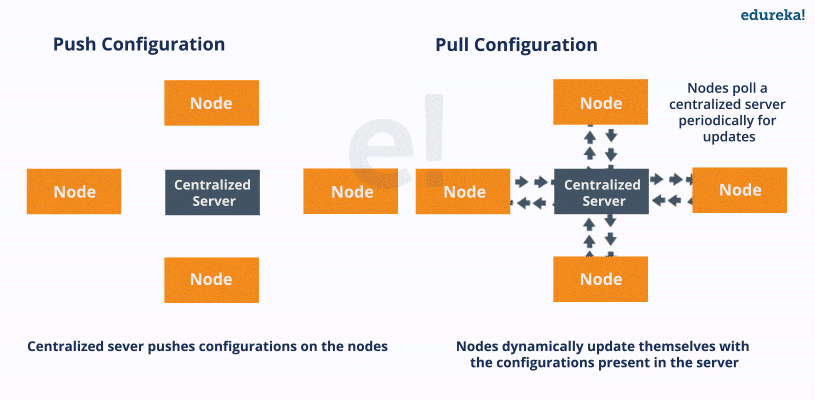DevOps Certification Training Course with Gen ...
- 190k Enrolled Learners
- Weekend/Weekday
- Live Class
Chef is a tool used for Configuration Management and is closely competing with Puppet. In this blog, I will explain What is Chef, Configuration Management and how Chef achieves Configuration Management with a use-case.
Chef is an automation tool that provides a way to define infrastructure as code. Infrastructure as code (IAC) simply means that managing infrastructure by writing code (Automating infrastructure) rather than using manual processes. It can also be termed as programmable infrastructure. Chef uses a pure-Ruby, domain-specific language (DSL) for writing system configurations. Below are the types of automation done by Chef, irrespective of the size of infrastructure:
Like Puppet which has a Master-Slave architecture even Chef has a Client-Server architecture. But Chef has an extra component called Workstation. I will talk about workstation in my next blog. Refer the diagram below:
In Chef, Nodes are dynamically updated with the configurations in the Server. This is called Pull Configuration which means that we don’t need to execute even a single command on the Chef server to push the configuration on the nodes, nodes will automatically update themselves with the configurations present in the Server. My next blog on Chef Tutorial will explain the Chef architecture along with all the Chef components in detail.
Now, let us look at reasons behind the popularity of Chef.
According to Phil Dibowitz, Production Engineer, Facebook
“There are three dimensions of scale we generally look at for infrastructure — the number of servers, the volume of different configurations across those systems, and the number of people required to maintain those configurations. Chef provided an automation solution flexible enough to bend to our scale dynamics without requiring us to change our workflow.”
Without a doubt Chef is one of the most famous Configuration Management tools and is closely competing with Puppet. But, before diving deep into “What is Chef”, it’s only fair that I first explain what is Configuration Management and why it is important.
Don’t worry, there won’t be any heavy definition of Configuration Management in this blog :)
Let us understand Configuration Management this way – suppose you have to deploy a software on top of hundreds of systems. This software can be an operating system or a code or it can be an update of an existing software. You can do this task manually, but what happens if you have to finish this task overnight because tomorrow might be a Big Billion Day sale in the company or some Mega Sale etc. in which heavy traffic is expected. Even if you were able to do this manually there is a high possibility of multiple errors on your big day. What if the software you updated on hundreds of systems is not working, then how will you revert back to the previous stable version, will you be able to do this task manually? AF-course not!
To solve this problem, Configuration Management was introduced. By using Configuration Management tools like Chef, Puppet, etc. you can automate this task. All you have to do is to specify the configurations in one centralized server and accordingly all the nodes will be configured. It allows access to an accurate historical record of system state for project management and audit purposes. So basically, we need to specify the configurations once on the central server and replicate that on thousands of nodes. Configuration Management helps in performing the below tasks in a very structured and easy way:
There are broadly two ways to manage your configurations namely Push and Pull configurations.

Learn various components of Configuration Management in my Puppet Tutorial Blog
Now is the correct time I take you ahead in this quest of understanding “What is Chef” by explaining how Chef achieves Configuration Management.
We have understood what is Chef, now I will explain you how Chef achieves Configuration Management with a use-case. Gannett is a publicly traded American media holding company. It is the largest U.S. newspaper publisher as measured by total daily circulation.
Gannett’s traditional deployment workflow was characterized by multiple handoffs and manual tests. Let us see what were the problems they faced with this process:
Gannett was ready for the change. Developers wanted to deploy their applications quickly. Operations wanted a stable infrastructure where they could build and deploy in a repeatable way. Finance wanted to know the true cost of an application. Security wanted to view and audit all stacks and to be able to track changes.
Gannett saw that cloud as a service offered many advantages. Developers had access to standardized resources. It was easier to handle peaky traffic because of cloud’s compute-on-demand model, and handoffs were minimized.
Chef allows you to dynamically provision and de-provision your infrastructure on demand to keep up with peaks in usage and traffic. It enables new services and features to be deployed and updated more frequently, with little risk of downtime. With Chef, you can take advantage of all the flexibility and cost savings that cloud offers.
Let us see what were the functions performed by Chef at Gannett:

Now is the time to understand what were the results of this process:
After “What is Chef” my next blog i.e. Chef Tutorial focuses on the architecture of Chef and its components. I have also explained how to deploy Apache2 using Chef.
If you found this blog on “What is Chef” relevant, check out DevOps Training by Edureka, a trusted online learning company with a network of more than 250,000 satisfied learners spread across the globe. The Edureka DevOps PGP course helps learners gain expertise in various DevOps processes and tools such as Puppet, Jenkins, Nagios and GIT for automating multiple steps in SDLC.
 Thank you for registering Join Edureka Meetup community for 100+ Free Webinars each month JOIN MEETUP GROUP
Thank you for registering Join Edureka Meetup community for 100+ Free Webinars each month JOIN MEETUP GROUPedureka.co
Most recent study shows that over 75% people are active into internet activities. On line arena is becoming bigger and more beneficial and providing a great number of make money online opportunities. Work at home on-line jobs are becoming poplar and improving individual’s lives. Precisely why it is extremely popular? Mainly because it enables you to do the job from anywhere and any time. You get much more time to devote with all your friends and can plan out journeys for vacations. Men and women are making pleasant earnings of $42000 per week by utilizing the efficient and intelligent methods. Carrying out right work in a right direction will definitely lead us towards becoming successful.